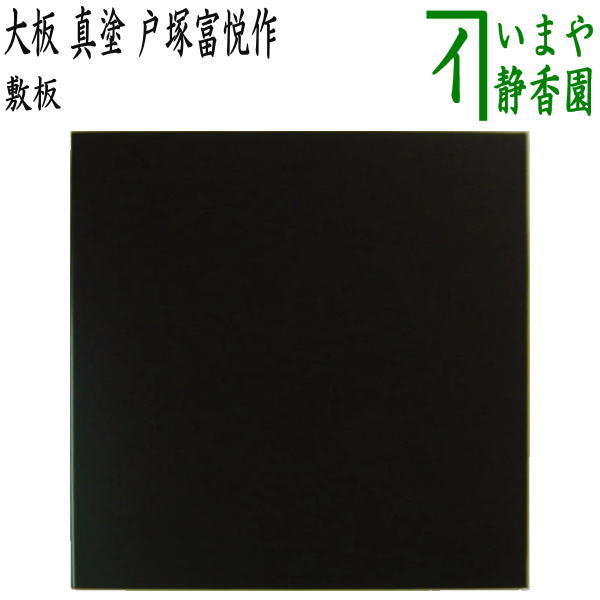1
/
of
1
[Tea utensils/tea ceremony tools, brazier base] Large board, painted with real paint, made of wood by Totsuka Tomiyoshi
[Tea utensils/tea ceremony tools, brazier base] Large board, painted with real paint, made of wood by Totsuka Tomiyoshi
Product Code: kamayousikiita-10
Regular price
13,750 円
Regular price
Sale price
13,750 円
Unit price
/
per
Tax included.
Shipping calculated at checkout.
Couldn't load pickup availability
●Shikiita (large board) is one of the boards that is placed under the furo, and is a board the size of a daisu (pedestal).
There are two types of base board: those that are square, measuring 1 shaku 4 sun square, and those that are the size of a long board cut in half, measuring 1 shaku 4 sun long and 1 shaku 2 sun wide; the latter are specifically called ``hanita'' (half board).
Currently, the main boards used are large boards 1 shaku 4 sun square (1 shaku 3 sun 5 bu) in the Omotesenke school, which are always placed and not used for in-between placement, boards 1 shaku 4 sun long and 1 shaku 2 sun wide called large boards in the Urasenke school, and boards 1 shaku 4 sun long and 1 shaku 2 sun wide called half boards in the Mushakojisenke school. In the Sekishu school, there are boards that are 9 sun 5 bu long, 9 sun 4 bu wide and 5 bu thick, and boards that are 9 sun 5 bu long, 9 sun 2 bu wide and 4 bu thick.
The large boards have a variety of designs, including true lacquer as preferred by Joo, keyaki kakiawase as preferred by the 7th head of the Omotesenke school, Joshinsai, paulownia kakiawase as preferred by the 11th head of the Omotesenke school, mulberry wood base as preferred by the 10th head of the Urasenke school, Nintokusai, ikkanbari as preferred by the 11th head of the Urasenke school, Gengensai, blue lacquer and red thread wrapping as preferred by the 14th head of the Urasenke school, black brush marks and blue lacquer and red thread wrapping as preferred by the 8th head of the Mushakojisen school, Issai, and paulownia wood base as preferred by the 9th head of the Mushakojisen school, Yoshisai.
The floor boards are classified into large, small and round boards according to their shape, and there are various boards depending on the type of furo, style and preference, such as shin-nuri (shin-nuri), kakiawase (kakiawase), arame (arame), kanname (kanname), etc. There are also ceramic floor tiles.
Size: Approx. 42.42 x 42.42 x 1.8 cm
Author: Totsuka Tomiyoshi
----------
Born in 1941 in Sabae City, Fukui Prefecture
In 1959, he was certified as a traditional craftsman and studied under Isamu Oon.
1961: Learned the joinery base process
1963: Learned the joinery finishing process
1964: Learned the wax coloring process
In 1965, he became independent and opened his own studio, where he is currently continuing his studies.
----------
Box: Paper box
There are two types of base board: those that are square, measuring 1 shaku 4 sun square, and those that are the size of a long board cut in half, measuring 1 shaku 4 sun long and 1 shaku 2 sun wide; the latter are specifically called ``hanita'' (half board).
Currently, the main boards used are large boards 1 shaku 4 sun square (1 shaku 3 sun 5 bu) in the Omotesenke school, which are always placed and not used for in-between placement, boards 1 shaku 4 sun long and 1 shaku 2 sun wide called large boards in the Urasenke school, and boards 1 shaku 4 sun long and 1 shaku 2 sun wide called half boards in the Mushakojisenke school. In the Sekishu school, there are boards that are 9 sun 5 bu long, 9 sun 4 bu wide and 5 bu thick, and boards that are 9 sun 5 bu long, 9 sun 2 bu wide and 4 bu thick.
The large boards have a variety of designs, including true lacquer as preferred by Joo, keyaki kakiawase as preferred by the 7th head of the Omotesenke school, Joshinsai, paulownia kakiawase as preferred by the 11th head of the Omotesenke school, mulberry wood base as preferred by the 10th head of the Urasenke school, Nintokusai, ikkanbari as preferred by the 11th head of the Urasenke school, Gengensai, blue lacquer and red thread wrapping as preferred by the 14th head of the Urasenke school, black brush marks and blue lacquer and red thread wrapping as preferred by the 8th head of the Mushakojisen school, Issai, and paulownia wood base as preferred by the 9th head of the Mushakojisen school, Yoshisai.
The floor boards are classified into large, small and round boards according to their shape, and there are various boards depending on the type of furo, style and preference, such as shin-nuri (shin-nuri), kakiawase (kakiawase), arame (arame), kanname (kanname), etc. There are also ceramic floor tiles.
Size: Approx. 42.42 x 42.42 x 1.8 cm
Author: Totsuka Tomiyoshi
----------
Born in 1941 in Sabae City, Fukui Prefecture
In 1959, he was certified as a traditional craftsman and studied under Isamu Oon.
1961: Learned the joinery base process
1963: Learned the joinery finishing process
1964: Learned the wax coloring process
In 1965, he became independent and opened his own studio, where he is currently continuing his studies.
----------
Box: Paper box
[About paid individual packaging]
If you would like individual packaging (charges apply), click View Cart, check "I would like individual packaging", and then add the desired quantity to "Quantity".
*The following products are not eligible for individual packaging. If you would like to package the folding fan or colored paper, we will provide a paid box or bag for each.
- Mail delivery products
- Folding fan (paid box available/no packaging)
- Colored paper (paid bag available/no packaging)
- Zodiac theme related products
【Related Category】
Share
![[Tea utensils/tea ceremony tools, brazier base] Large board, painted with real paint, made of wood by Totsuka Tomiyoshi](http://imaya.co.jp/cdn/shop/products/kamayousikiita-10_1.jpg?v=1709082476&width=1445)





















